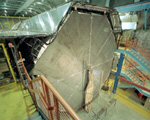Updating Magic Universe
A new conundrum about neutrinos
 Billions of them are passing through your body right now. With no electric charge and very little mass, neutrinos are the most penetrating of the commonplace particles of the Universe – and the shyest. Detecting them calls for experiments on a monumental scale. To figure out their properties requires immense patience too, and big steps forward are few and far between. But, as announced today at the Neutrino 2010 meeting in Athens, a multinational team is 95% sure that there’s a greater contrast between the masses of different kinds of anti-neutrinos, than between different kinds of neutrinos.
Billions of them are passing through your body right now. With no electric charge and very little mass, neutrinos are the most penetrating of the commonplace particles of the Universe – and the shyest. Detecting them calls for experiments on a monumental scale. To figure out their properties requires immense patience too, and big steps forward are few and far between. But, as announced today at the Neutrino 2010 meeting in Athens, a multinational team is 95% sure that there’s a greater contrast between the masses of different kinds of anti-neutrinos, than between different kinds of neutrinos.

The MINOS far detector in the Soudan Underground Laboratory consists of 486 octagonal steel sheets weighing 6000 tons altogether. Although billions of accelerated particles generate neutrinos every two seconds, the MINOS collaboration records only about 1000 neutrinos per year.
The work’s being done in the MINOS experiment (Main Injector Neutrino Oscillation Search) wherein a beam of muon neutrinos travels below the ground for 735 km, from Fermilab in Illinois to detectors deep in the Soudan mine in Minnesota. On the way, some of the muon neutrinos νμ change their “flavour” to become tau neutrinos ντ or, more rarely, electron neutrinos νe. Ditto for muon anti-neutrinos, when the Main Injector is set to create those instead.
Jenny Thomas of University College London, MINOS co-spokesperson, is quoted as saying:
We do know that a difference of this size in the behaviour of neutrinos and anti-neutrinos could not be explained by current theory. While the neutrinos and anti-neutrinos do behave differently on their journey through the Earth, the Standard Model [of particle physics] predicts the effect is immeasurably small in the MINOS experiment. Clearly, more anti-neutrino running is essential to clarify whether this effect is just due to a statistical fluctuation or the first hint of new physics.
If confirmed, this will be an important update for the story in Magic Universe called “Neutrino oscillations: when ghostly particles play hide-and-seek”. It tells the tale of Raymond Davis’s failure to detect the expected number of neutrinos from solar nuclear reactions, with a pioneering experiment in Homestake Mine in the Black Hills of Dakota. It led to the joky question, “Is the Sun still burning?”.




 Posted by calderup
Posted by calderup 

